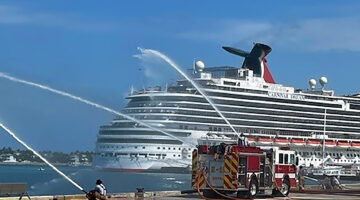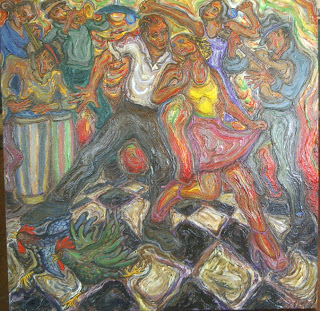Through His Art And Words The Brilliance Of George Crosby
By Emil Imbro
I first met George Lee Crosby on Higgs Beach among a group of “washashores” in
the mid 1990’s, where his beachfront dissertations on the world could be heard a
mile away.
He spoke eloquently about all the places he’d been with a colorful choice of
words: “Sagacious… miasma… internecine… mercurial.” In normal discussion he
always had me listening intently, trying to grasp all that he was saying.
We both were raised in New York City and went “to different schools together,”
as they say, which sparked a friendship that has lasted twenty years.
George is back from from one of his many visits to Cuba and has now captured
the life and street scenes of that island through his art the way he has done for so
many years in Key West.
I remember visiting with him painting on the porch of the former Captain
Outrageous Gallery at 525 Caroline Street, listening to Cuban radio Rebelde,
direct from Havana, while fielding questions from clients and passersby, all the
while taking issue with the commentary on the radio with verbal outbursts in
Spanish.
Like Van Gogh, who spent the later years of his life in an asylum, dying before he
knew the recognition his work would achieve, I could see an earless George
transported back from an asylum in Arles, France, to our southernmost
sanitarium, wondering why the world had not yet beaten a well worn path to his
door. For he is the consummate “ahrtist,” as the Maine vernacular would have it.
It’s not about the selling of his work. Its about the painting. Just the painting.
Only the painting. That is his passion. To be left alone with palette and brush. To
paint the places where he has worked and played, ate and drank, laughed and
cried, through the windows of his mind, in the name of art.
Born in 1949, George attended prep school in New Jersey, then went on to study
Journalism at the University of Michigan. Living next door to the University Art
School in Ann Arbor, the smell of oil paint began to seep into his pores and he
started to paint.
He took a bold step with no safety net when in 1971, he took the money for next
semesters tuition and hitchhiked to New York City. There he lived in the movie
theatres on Times Square by night while exploring the streets of the city by day.
With luck and undeniable flair he applied for and got a scholarship to Cooper
Union to study painting. There he was discovered by a professor who told him,
“Only a few people are born with talent. You’ve got talent son.”
He dropped out of Cooper Union and went to Provincetown to study ”at the foot
of the master” with Henry Hensche.
After a short but intense period with Hensche, and growing tired of the cold New
England winters, George heard you could live in Mexico City for 50 cents a day.
So he moved to Mexico City to attend the San Carlos Academy studying
portraiture and spending winters in Puerto Vallarta where he learned “street
Spanish” and found an affinity for life at the beach and painting beach scenes.
In 1975, he returned to New York and rented a cold water flat in Union Square
inhabited by other starving artists. He moved furniture and drove cabs to pay the
bills while attending the ultimate post-doctoral program for any artist, which is to
study the works of the masters while wandering the museums and art galleries of
New York.
In 1977, he left the city once again to join his conch girlfriend in Key West. Here
he fell in love with the still unspoiled beauty of the island. He landed a job as
second mate on crawfish boat and began to paint Key West scenes.
In 1986, he met his future wife a Japanese exchange student and spent the next 6
years working as an illustrator in Tokyo and traveling through China, Southeast
Asia and India, seeing things and recording them on the canvas in his mind.
In 1996, he travelled the world backwards through Asia to India and Europe and
back to New York. He returned to Key West in winter and began showing at
Gallery on Greene, then at Lazy Way Lane Gallery owned by Rachel Collins Kelly.
Kelly described his work as “plein-air extraordinaire.” Crosby then began showing
at the Captain Outrageous Gallery until the Captains death in 2007. The Captain
said, “Crosby is the best artist I ever saw come through Key West.”
George now divides his time between Key West and his home in Blue Hill, Maine.
He is showing his works called, “Paintings from Cuba and Key West by George Lee
Crosby” beginning on January 10th at Stone Soup Gallery at 802 White Street
where he will also be having a show the third Thursday of the month (21st). All of
his work can also be seen at www.bluehillartist.com or just Google “George
Crosby”
[livemarket market_name="KONK Life LiveMarket" limit=3 category=“” show_signup=0 show_more=0]


No Comment